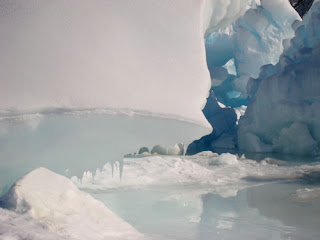
that has been glazed and is awaiting firing

samples for research from Andrill Core

from box beneath rock trimsaw
 John working on an intricate pattern on a vase.
John working on an intricate pattern on a vase.John is a master of patience and a ceramics room guru.
First of all, the material I had from the saw included lots of silt and coarser particles, so I had to wet it, make it really goopy, and put it through a sieve. John suggested that I try a mold.

The goopy mud mixture I used in my efforts to make a penguin mold
Penguin #1
They have a neat penguin mold. Basically one just pours the goopy clay in, then pours it out again, and repeats several times, then leave it for 24 to 48 hours to dry somewhat, then take it out, let it dry a bit more, then sand any irregularities off, and it is ready for ‘bisque-firing’ or ‘low firing’ in the kiln. This was all really exciting, and I got lots of help from people – they were all quite curious to see whether it would work.
 Denise works on trimming one of her works of art
Denise works on trimming one of her works of artSo far so good. It came out of the kiln after bisque firing a deep reddish-brown color. I did not think to take any pictures of my prized Andrill penguin. I then decided I would just clear glaze it – I thought that the natural purity of 13 million-year-old McMurdo Sound clay and silt in my artwork should be allowed to shine through.

Gena working on adding handles to some cups. She is a cup-making demon.
She works as a Helo-Tech (the person who helps people buckle themselves safely
into a helicopter, and makes sure the cargo is loaded safely,
and rides with the pilot and helps in landings and take-offs).
Several days later I went in to the ceramics room and Gena looked at me with downcast eyes “I have some sad news for you.” My penguin had collapsed and turned in to a glazed mass of pottery –but it was a beautiful deep green color.
 Remains of penguin #1
Remains of penguin #1Moral of the story: One cannot ‘high fire’ Andrill penguins because the material does not have enough clay in it to bind it –it is too silty, and it just 'flows'. The experts in the ceramics room all reckon that I will be able to low-fire Andrill creations without them collapsing, because the low fire is the same temperature as the bisque-firing, which we know worked. We have yet to see …
Penguin # 2
Penguin # 3
I poured the goopy mixture into the mold again, and left it to dry – carefully making sure that I trimmed the material at the top. That was Sunday. Monday I went to Cape Evans (and saw REAL penguins), then I was working Tuesday, Wednesday and Thursday evenings. Whoops. I went in tonight, and the penguin was cracked – I had left it in the mold too long.

Ceramic penguin rookery - the creations of Dave - who helped me save Trivet # 2
Dave hand sculpts marine mammals. He is currently working on a fish for one of the biologists.
Penguin # 4
I poured it into the mold tonight (Friday 30th), and I am hoping that everything works. I will have to make sure that I get back to the ceramics room sometime before Sunday night.
Trivet # 1
I have also tried making several trivets. Basically I added ordinary clay to the Andrill clay and I let it dry out a bit, then I rolled it out, and let it dry a bit more until I could carve the texture for my picture into the clay. The first one is a map of Antarctica showing the winter and summer sea-ice extent. It has just been bisque-fired, but is not out of the kiln yet. It definitely won’t make it into a museum – it was quite buckled and upturned at the edges before going in to the kiln – but I am hoping it stays in one piece, so I can glaze it.
Trivet # 2
I used the same process as for Trivet # 1, except I scored it more (too) deeply to prevent it from curling or buckling. I carved a scence from Beacon Valley into it. Then I lifted it up, and it broke along the score lines. Luckily Dave and John were there, and Dave helped me patch it with paper clay. Today I tried to tidy up the carved surface, and put it on the shelf for bisque firing.
I’ll miss the ceramics room – playing around and being creative is something I do not normally get the time to do, and I have really enjoyed going there when I have the time. I have also gotten to meet and talk with people at McMurdo that are not part of Andrill, which is good.
Brie (she is a baker in the kitchen) and
Meredith (works in the kitchen) work on their creations
So, even if Penguin #4 bites the dust, I’ll still be happy about all the time I spent over there – thanks y’all. I've accepted the reality that I will not create a museum centerpiece - I just hope that something I make stays together so I can take it home!





















































